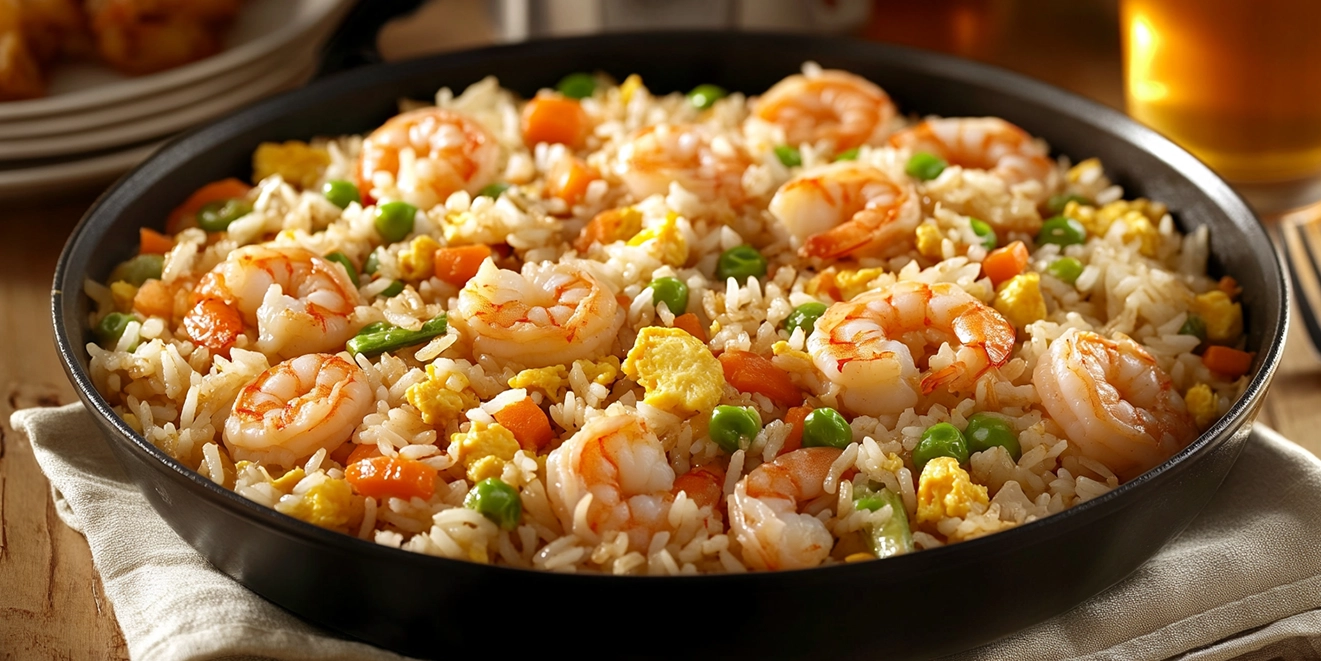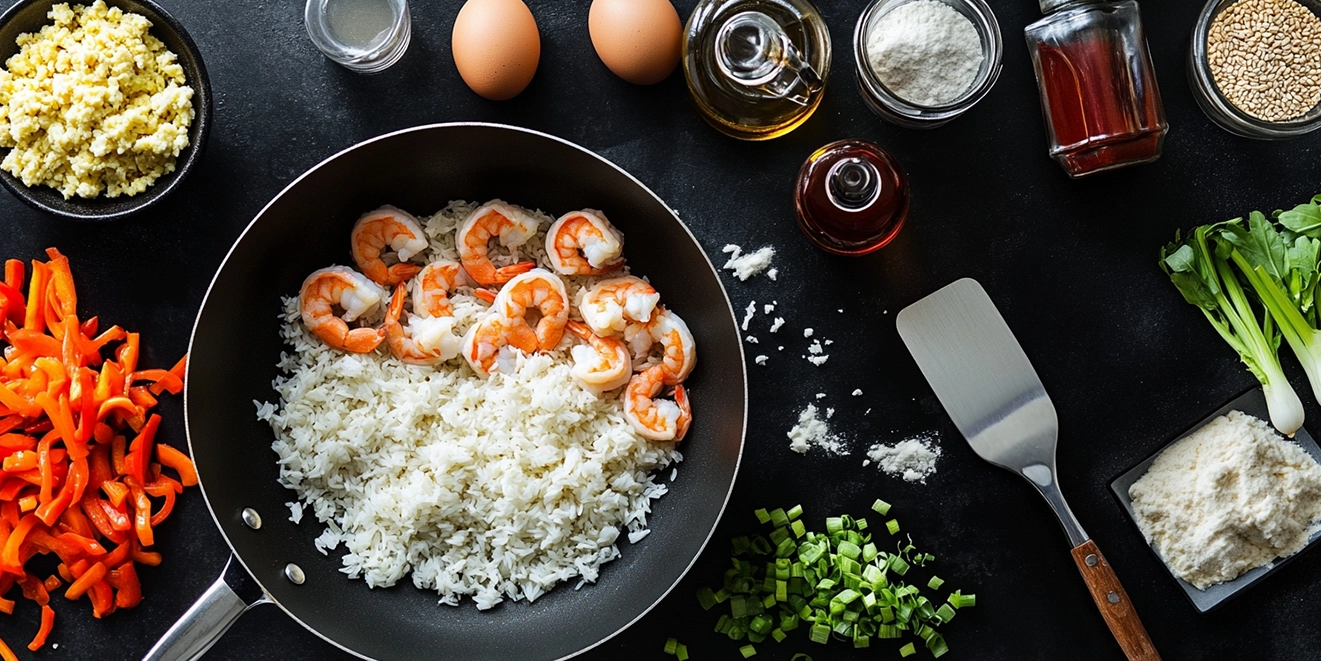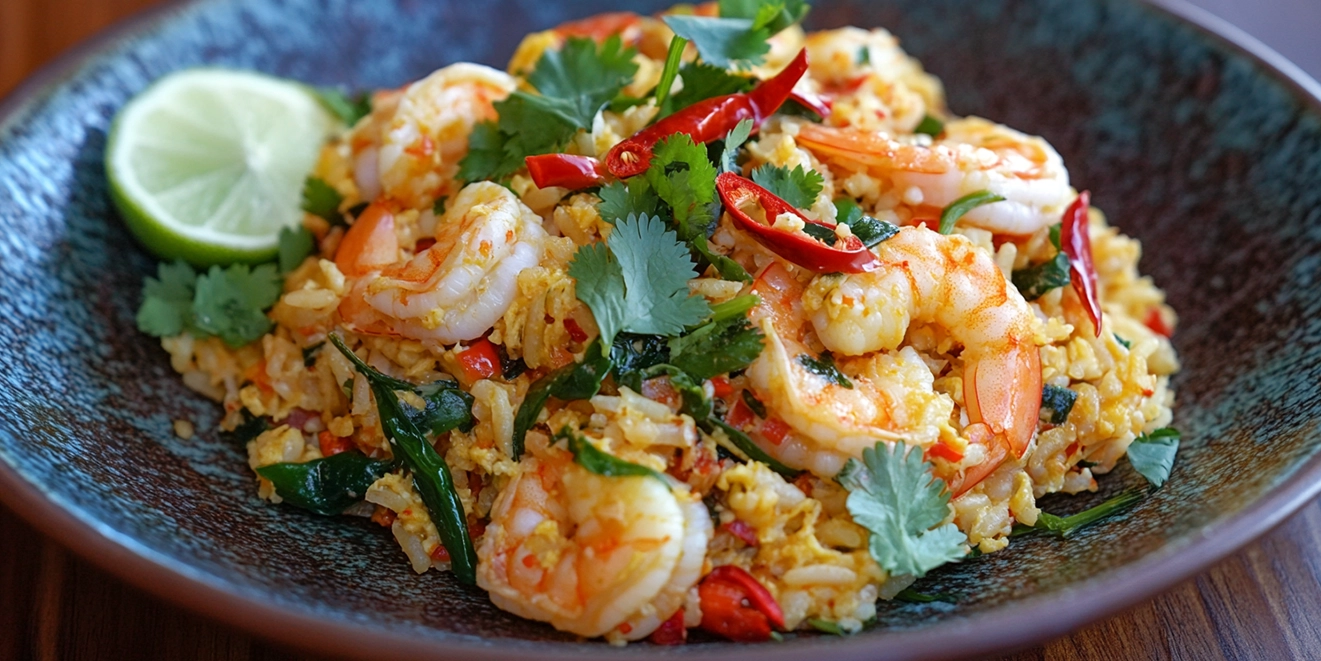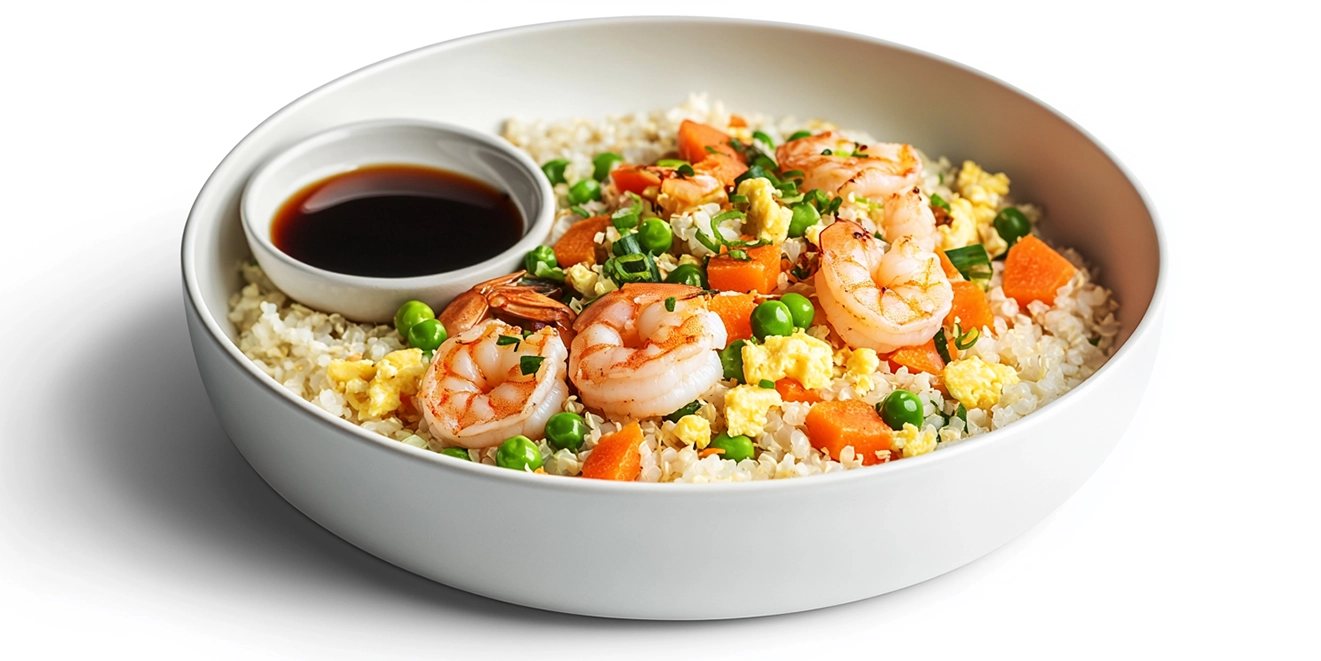How to Make Perfect Shrimp Fried Rice: Recipe, Tips, and Variations

Introduction to Shrimp Fried Rice
What is Shrimp Fried Rice?
Shrimp Fried Rice is a beloved dish that combines cooked rice, juicy shrimp, vegetables, and flavorful seasonings, all stir-fried to perfection in a hot wok or skillet. It’s a versatile meal, often seasoned with soy sauce, garlic, and sesame oil, providing a savory and slightly smoky flavor. This dish is popular for its quick preparation time and ability to use leftover rice, making it a go-to recipe for busy households or casual dinners.
History and Origin of Fried Rice
Fried rice originated in China during the Sui Dynasty (589–618 AD) when leftover rice was repurposed to create a flavorful, filling dish. Over centuries, the concept spread across Asia, evolving with local ingredients and tastes. In regions with access to fresh seafood, such as coastal China and Southeast Asia, shrimp became a natural addition, turning this humble dish into a gourmet delight.
Why Shrimp Fried Rice is Popular
Shrimp Fried Rice is popular for several reasons:
- Ease of Preparation: It requires minimal cooking time and basic pantry staples, making it accessible for cooks of all skill levels.
- Nutritional Value: Shrimp is a low-calorie protein packed with vitamins and minerals, while vegetables add fiber and nutrients.
- Flavor Versatility: The combination of shrimp, rice, and seasonings allows for endless customization and appeals to a wide range of palates.
- Global Appeal: While rooted in Asian cuisine, Shrimp Fried Rice has become a staple worldwide, adapted to various cultural preferences and ingredients.
Key Ingredients for Shrimp Fried Rice
Selecting the Best Shrimp
The quality of shrimp is crucial for making flavorful Shrimp Fried Rice. Here are some tips:
- Fresh vs. Frozen: Fresh shrimp is ideal for flavor and texture, but high-quality frozen shrimp works well, too. To save time, look for shrimp that is peeled and deveined.
- Size Matters: Medium-sized shrimp (30-40 counts per pound) strike a perfect balance between being bite-sized and substantial enough to stand out in the dish.
- Prepping Tips: If using fresh shrimp, clean them thoroughly and pat them dry before cooking to prevent excess water from diluting the flavors.
Choosing the Right Rice
Rice is the backbone of this dish, and selecting the right type is essential:
- Day-Old Rice: Leftover rice works best as it is dry and less likely to clump. Freshly cooked rice tends to be too moist and sticky for frying.
- Type of Rice: Long-grain varieties like jasmine or basmati rice are ideal for their fluffy texture and ability to hold up during stir-frying.
- Preparation Tip: If you don’t have leftover rice, spread freshly cooked rice on a baking sheet and refrigerate it for 30 minutes to remove excess moisture.
Essential Spices and Flavorings
The secret to an irresistible Shrimp Fried Rice lies in the spices and seasonings:
- Soy Sauce: Adds a savory umami flavor and a touch of saltiness.
- Sesame Oil: Provides a nutty aroma and enhances the overall taste.
- Garlic and Ginger: These aromatics form the flavor base and elevate the dish’s complexity.
- Vegetables: Common choices include peas, carrots, scallions, and bell peppers for color and texture.
- Optional Additions: Chili flakes or sriracha for heat, a splash of oyster sauce for richness, or a hint of lime juice for a zesty twist.

Preparation Steps
Cleaning and Deveining Shrimp
Properly preparing shrimp ensures a clean, flavorful result:
- Thaw (if frozen): Place frozen shrimp in a bowl of cold water for 10-15 minutes until fully thawed.
- Remove Shells: Peel off the outer shell, leaving the tail on or off based on preference.
- Devein: Use a small knife or a deveining tool to remove the black vein along the back of the shrimp. This vein is the digestive tract and can have a gritty texture if left intact.
- Rinse: Rinse the shrimp under cold water and pat dry with paper towels to remove excess moisture.
Cooking Rice for Perfect Texture
For the best results, adequately cooked rice is essential:
- Choose the Right Rice: Use long-grain varieties like jasmine or basmati for a light, fluffy texture.
- Cook the Rice: Follow the package instructions, ensuring the rice is not overcooked. Use slightly less water than usual to keep the grains firm.
- Cool the Rice: Spread the cooked rice on a baking sheet and let it cool to room temperature. For best results, refrigerate the rice for a few hours or overnight to dry out the grains.
Prepping Vegetables
Vegetables add color, texture, and nutrition to Shrimp Fried Rice. Here’s how to prepare them:
- Wash and Dry: Thoroughly wash all vegetables to remove dirt or debris. Dry them well to prevent sogginess during cooking.
- Chop Uniformly: Dice carrots, bell peppers, and other vegetables into small, uniform pieces to ensure even cooking. Slice scallions thinly for garnish.
- Thaw Frozen Vegetables: If using frozen peas or mixed vegetables, allow them to thaw slightly or rinse under warm water to speed up the process. Drain thoroughly.
Tools You’ll Need
Must-Have Kitchen Utensils
To prepare Shrimp Fried Rice efficiently, these kitchen essentials are highly recommended:
- Cutting Board: A sturdy surface for chopping vegetables and prepping shrimp.
- Sharp Knife: Essential for slicing, dicing, and cleaning ingredients with precision.
- Mixing Bowls: These hold prepped ingredients such as chopped vegetables, shrimp, and rice.
- Spatula or Wooden Spoon: A wide spatula is perfect for stir-frying, allowing you to toss and mix the ingredients evenly.
- Colander: Useful for rinsing shrimp and vegetables to ensure they are clean and free of excess water.
Choosing the Right Wok or Pan
The cooking vessel you use significantly impacts the flavor and texture of your Shrimp Fried Rice:
- Wok:
- Why a Wok?: Its round bottom and high sides allow for even heat distribution and quick cooking. The large surface area makes tossing ingredients easier, ensuring even coating and preventing sticking.
- Material: Carbon steel woks are lightweight, durable, and heat up quickly, making them ideal for stir-frying.
- Large Skillet or Frying Pan:
- If you don’t have a wok, a heavy-bottomed skillet or frying pan can substitute. Choose a pan with a wide surface to prevent overcrowding.
- Non-Stick Option: Non-stick pans are great for beginners as they prevent the rice from sticking and make cleanup easier.
The Classic Shrimp Fried Rice Recipe

Step-by-Step Instructions
Follow these easy steps to make a delicious and authentic Shrimp Fried Rice:
Ingredients:
- 2 cups cooked and cooled rice (preferably day-old)
- 1/2 pound medium shrimp (peeled and deveined)
- 1 cup mixed vegetables (carrots, peas, bell peppers)
- Two large eggs
- Three tablespoons soy sauce
- One tablespoon of sesame oil
- Two tablespoons of vegetable oil
- Two garlic cloves (minced)
- One teaspoon of grated ginger
- Two scallions (thinly sliced)
- Salt and pepper to taste
Instructions:
- Prepare the Shrimp: Season the cleaned shrimp with salt and pepper. Heat one tablespoon of vegetable oil in a wok or large pan over medium-high heat. Sear the shrimp on each side for 1-2 minutes until pink and cooked through. Remove and set aside.
- Scramble the Eggs: Add another tablespoon of vegetable oil in the same wok. Crack the eggs into the pan, scramble them, and cook until set. Remove and set aside.
- Cook the Vegetables: Add the garlic and ginger to the wok, stirring until fragrant (about 30 seconds). Add the mixed vegetables and stir-fry for 2-3 minutes until tender but crisp.
- Fry the Rice: Increase the heat to high and add the cooled rice to the wok. Stir continuously, breaking up any clumps, so the rice is evenly heated and slightly toasted.
- Season the Dish: Drizzle the soy sauce and sesame oil over the rice, tossing to coat evenly. Adjust seasoning with salt and pepper if needed.
- Combine Ingredients: Add the cooked shrimp, scrambled eggs, and scallions back into the wok. Stir well to combine all ingredients. Cook for another 1-2 minutes to ensure everything is heated through.
- Serve: Transfer the Shrimp Fried Rice to a serving dish and garnish with extra scallions or a squeeze of lime juice for added flavor. Serve hot and enjoy!
Cooking Tips for Authentic Flavor
- Use High Heat: Cooking at high heat ensures that the ingredients fry rather than steam, giving the dish its signature smoky flavor (known as “wok hei” in Chinese cuisine).
- Don’t Overcrowd the Pan: Work in batches if necessary to maintain high heat and avoid soggy fried rice.
- Prep in Advance: Have all ingredients prepped and within reach before you start cooking to prevent overcooking.
- Customize Your Add-Ins: Enhance the dish with extras like diced pineapple, cooked bacon, or chili paste for heat.
- Use Leftover Rice: Day-old rice works best for fried rice because it’s drier and won’t clump together in the pan.
Variations of Shrimp Fried Rice
Healthier Alternatives
For a lighter, healthier version of Shrimp Fried Rice, consider these modifications:
- Use Brown Rice or Quinoa: Swap white rice for brown rice or quinoa for added fiber and nutrients. Both options hold up well during stir-frying.
- Reduce Oil: Use a non-stick pan and cut back on oil without sacrificing flavor.
- Add More Vegetables: Increase the vegetable-to-rice ratio by adding spinach, broccoli, zucchini, or mushrooms for extra vitamins and minerals.
- Limit Sodium: To control salt levels choose low-sodium soy sauce or tamari. You can also add a splash of lemon juice for flavor enhancement without extra salt.
Vegan and Gluten-Free Versions
Creating a vegan or gluten-free Shrimp Fried Rice is simple with the proper substitutions:
Vegan Version:
- Replace Shrimp: Substitute with plant-based shrimp, tofu cubes, or chickpeas for a protein-rich alternative.
- Egg-Free: Use crumbled firm tofu or a chickpea flour scramble instead of eggs for texture.
- Vegan Sauces: Ensure soy sauce and any additional sauces are vegan-friendly. Coconut aminos can be a great soy sauce substitute.
Gluten-Free Version:
- Choose Gluten-Free Soy Sauce: Replace regular soy sauce with tamari or gluten-free soy sauce.
- Check Ingredients: Ensure all packaged ingredients, including sauces and spices, are certified gluten-free.
- Base Options: Use gluten-free grains like rice, millet, or cauliflower rice.
Regional Takes on the Dish
Shrimp Fried Rice is versatile and has been adapted across different cuisines:
- Thai Style:
- Key Ingredients: Add fish sauce, sugar, and fresh lime juice. Garnish with cilantro and serve with cucumber slices for a refreshing contrast.
- Indonesian Nasi Goreng:
- Key Ingredients: For a hearty meal, incorporate sweet soy sauce (kecap manis) and chili paste. Top with a fried egg.
- Japanese Style:
- Key Ingredients: Use short-grain rice, add soy sauce, mirin, and sake for flavor, and incorporate green onions, pickled ginger, and sesame seeds for garnish.
- American-Chinese Style:
- Key Ingredients: Include diced ham or cooked chicken along with shrimp. For richer flavor, often use extra soy sauce and oyster sauce.
Nutritional Value of Shrimp Fried Rice
Calorie Count
The calorie content of Shrimp Fried Rice varies depending on the portion size and ingredients used. On average:
- One cup (about 200 grams) of Shrimp Fried Rice contains approximately 250-350 calories.
- Using less oil, brown rice, or additional vegetables can reduce calorie density while adding extras like fried eggs or bacon will increase it.
Protein and Carbohydrate Breakdown
- Protein:
- Shrimp is a lean protein source, offering around 20-24 grams of protein per cup of fried rice.
- Eggs also contribute to the protein content, typically adding 6-8 grams depending on the number used.
- Carbohydrates:
- Rice is the primary carbohydrate source, contributing approximately 40-50 grams of carbs per cup.
- Opting for brown rice can increase dietary fiber, promoting better digestion and sustained energy.
- Fats:
- The dish typically contains 8-12 grams of fat per serving, depending on the amount of oil and additional ingredients like sesame or butter.
Vitamins and Minerals Present
Shrimp Fried Rice provides a wide range of essential vitamins and minerals:
- From Shrimp:
- Vitamin B12: Supports nerve function and red blood cell production.
- Selenium: An antioxidant that helps boost the immune system.
- Omega-3 Fatty Acids: Beneficial for heart and brain health.
- From Vegetables:
- Vitamin A (carrots): Supports eye health and immunity.
- Vitamin C (bell peppers, peas): Enhances skin health and boosts the immune system.
- Folate (peas, spinach): Essential for DNA synthesis and repair.
- From Rice:
- Magnesium: Important for muscle and nerve function.
- Iron: Helps transport oxygen in the blood.
- Optional Additions:
- Adding scallions provides Vitamin K and antioxidants.
- Using sesame oil contributes a small amount of healthy fats and vitamin E.
Overall Nutritional Benefits
Shrimp Fried Rice is a well-balanced dish that provides the following:
- Energy: From carbohydrates in the rice.
- Protein: For muscle repair and satiety.
- Essential Micronutrients: From shrimp and vegetables, supporting overall health.

Common Mistakes to Avoid
Overcooking Shrimp
Shrimp cooks very quickly and can become rubbery if overdone.
- Solution: Cook shrimp on medium-high heat for 1-2 minutes per side until they turn pink and opaque. Remove them from the pan as soon as they’re done, and add them back later to avoid overcooking.
Using the Wrong Type of Rice
Freshly cooked rice or certain types of rice can result in a mushy texture.
- Solution: Use day-old, refrigerated rice for the best texture. Long-grain rice, such as jasmine or basmati, works well because it stays firm and fluffy during stir-frying. If you only have freshly cooked rice, spread it on a tray and chill it for 30 minutes to dry it out.
Not Preheating the Pan
A cold pan can lead to uneven cooking and soggy fried rice.
- Solution: Preheat your wok or skillet over high heat before adding oil. An adequately heated pan ensures the ingredients cook quickly, retaining their texture and preventing sticking.
Additional Tips to Avoid Mistakes
- Overcrowding the Pan: Adding too many ingredients simultaneously lowers the pan’s temperature, resulting in steaming instead of frying.
- Fix: Cook in batches if necessary to maintain high heat.
- Skipping Ingredient Prep: Stir-frying is fast, and any delay can cause overcooking.
- Fix: Have all ingredients prepped and ready to go before cooking.
- Too Much Liquid: Excess soy sauce or other liquids can make the rice soggy.
- Fix: Add liquids sparingly, tasting as you go, and ensure your rice is dry before frying.
Pairing Shrimp Fried Rice with Other Dishes
Best Side Dishes to Complement
Shrimp Fried Rice pairs beautifully with a variety of side dishes to create a balanced and flavorful meal:
- Spring Rolls or Egg Rolls
- These crispy appetizers filled with vegetables, meat, or seafood add a crunchy texture to complement the soft, savory rice.
- Asian-Style Soups
- Hot and Sour Soup: Offers a tangy and spicy contrast to the rich flavors of fried rice.
- Miso Soup: A lighter option that balances the meal with umami.
- Steamed or Stir-Fried Vegetables
- Broccoli, bok choy, snap peas, or baby corn stir-fried with garlic and soy sauce make a healthy and delicious pairing.
- Grilled or Glazed Meats
- Teriyaki chicken, honey-glazed salmon, or sweet-and-sour pork add protein and complementary flavors to the meal.
- Dumplings
- Steamed or pan-fried dumplings filled with vegetables, shrimp, or pork provide a hearty and satisfying addition.
- Pickled Vegetables
- Kimchi or pickled radish can offer a tangy and spicy element to enhance the dish’s flavors.
Consider pairing your shrimp fried rice with a complementary dish to elevate it. For example, this flavorful Shrimp Pasta Recipe adds a creamy touch to your dinner spread.
Beverages that Pair Well
Choosing the right beverage enhances the dining experience:
- Tea
- Jasmine Tea: A fragrant, light tea that cleanses the palate between bites.
- Green Tea: Offers a subtle bitterness that complements the dish’s savory elements.
- Non-Alcoholic Options
- Sparkling Water with Lime: A refreshing choice that cleanses the palate.
- Iced Green Tea Provides a cooling and slightly earthy pairing.
- Fruit Juices: Pineapple or mango juice adds a tropical sweetness to contrast with the savory flavors.
Frequently Asked Questions
Can Shrimp Fried Rice Be Frozen?
Yes, Shrimp Fried Rice can be frozen for up to 3 months.
- How to Freeze: Allow the rice to cool completely, then transfer it to an airtight container or freezer bag.
- How to Reheat: Thaw in the refrigerator overnight and reheat in a skillet or microwave. Add a water or soy sauce splash to restore moisture and flavor during reheating.
Is Special Fried Rice Healthy?
The healthiness of special fried rice depends on the ingredients and preparation method:
- Healthier Options: Use brown rice, add plenty of vegetables, and reduce oil and sodium.
- Potential Concerns: Fried rice can be high in calories, sodium, and fats, mainly if it contains processed meats like ham or excessive sauces. Balance it with lean proteins and nutrient-rich vegetables for a healthier version.
What Does Shrimp Fried Rice Contain?
Shrimp Fried Rice typically contains:
- Protein: Shrimp and sometimes eggs.
- Carbohydrates: Cooked rice, preferably day-old.
- Vegetables: Common additions include peas, carrots, bell peppers, and scallions.
- Seasonings: Soy sauce, sesame oil, garlic, and ginger for flavor.
- Optional Additions: Chili flakes, oyster sauce, lime juice, or fresh herbs for extra flavor.
How Do You Make Fried Rice Taste Better?
To enhance the flavor of fried rice:
- Use Day-Old Rice: This prevents sogginess and allows the rice to absorb flavors better.
- Cook Over High Heat: High heat gives the dish a smoky flavor (wok hei).
- Add Layers of Flavor: Use garlic, ginger, sesame oil, soy sauce, and optional spices like chili flakes or five-spice powder.
- Include Fresh Ingredients: Incorporate fresh vegetables, herbs, and high-quality shrimp for a vibrant taste.
- Finish with Garnish: Top with fresh scallions, sesame seeds, or a drizzle of lime juice for a burst of freshness.
Related Recipes to Explore
To diversify your meal planning, check out these related recipes:
- If you’re looking for another hearty dish, try this Dirty Rice Recipe for a Cajun twist.
- For a delightful appetizer, the Spinach Dip Recipe is always a crowd-pleaser.
- Need a sweet ending? This Apple Cobbler Recipe pairs beautifully with a savory main course.
Conclusion
Shrimp fried rice is a versatile dish that can stand alone or complement other recipes. By incorporating internal links to related recipes, such as What Goes With Shrimp Pasta and Rasta Pasta Recipe, you enrich your culinary journey and make your dining experience seamless.
You can elevate this humble dish into a standout meal by avoiding common mistakes, selecting quality ingredients, and pairing it with complementary sides and beverages. With its rich history, nutritional benefits, and universal appeal, Shrimp Fried Rice is more than just a recipe—it celebrates taste, convenience, and creativity in the kitchen.
Enjoy cooking, sharing, and savoring this timeless favorite!
